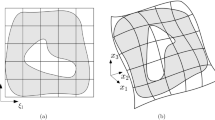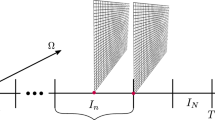Summary
In this paper, we investigate the discretization of an elliptic boundary value problem in 3D by means of the hp-version of the finite element method using a mesh of tetrahedrons. We present several bases based on integrated Jacobi polynomials in which the element stiffness matrix has \({\mathcal{O}}(p^3)\) nonzero entries, where p denotes the polynomial degree. The proof of the sparsity requires the assistance of computer algebra software. Several numerical experiments show the efficiency of the proposed bases for higher polynomial degrees p.
Similar content being viewed by others
References
(1965). Handbook of mathematical functions. Dover, New York
Ainsworth M. and Coyle J. (2003). Hierarchic finite element bases on unstructured tetrahedral meshes. Int J Numer Methods Eng 58(14): 2103–2130
Ainsworth, M., Demkowicz, L.: Explicit polynomial preserving trace liftings on a triangle. Technical Report TICAM Report 03-47, TICAM (2003)
Ainsworth M. and Guo B. (2000). An additive Schwarz preconditioner for p-version boundary element approximation of the hypersingular operator in three dimensions. Numer Math 85(3): 343–366
Andrews, G. E., Askey, R., Roy, R.: Special functions. Encyclopedia of Mathematics and its Applications, vol. 71. Cambridge University Press, London (1999)
Babuška I., Craig A., Mandel J. and Pitkäranta J. (1991). Efficent preconditioning for the p-version finite element method in two dimensions. SIAM J Numer Anal 28(3): 624–661
Babuška I., Griebel M. and Pitkäranta J. (1989). The problem of selecting the shape functions for a p-type finite element. Int J Numer Methods Eng 28: 1891–1908
Bećirović, A., Paule, P., Pillwein, V., Riese, A., Schneider, C., Schöberl, J.: Hypergeometric summation algorithms for high-order finite elements. Technical Report 2006-08, SFB F013, JKU Linz (2006) Computing (forthcoming)
Beuchler S. (2005). Extension operators on tensor product structures in two and three dimensions. SIAM J Sci Comput 26(5): 1776–1795
Beuchler, S., Pillwein, V.: Completions to sparse shape functions for triangular and tetrahedral p-fem. Technical Report 2006-35, SFB F013, JKU Linz 2006 (Proceedings of the DD17) (to appear)
Beuchler, S., Pillwein, V.: Shape functions for tetrahedral p-fem using integrated jacobi polynomials. Technical Report 2006-34, SFB F013, JKU Linz (2006)
Beuchler S., Schneider R. and Schwab C. (2004). Multiresolution weighted norm equivalences and applications. Numer Math 98(1): 67–97
Beuchler S. and Schöberl J. (2006). New shape functions for triangular p-fem using integrated jacobi polynomials. Numer Math 103: 339–366
Duffy M.G. (1982). Quadrature over a pyramid or cube of integrands with a singularity at a vertex. SIAM J Numer Anal 19(6): 1260–1262
George A. (1973). Nested dissection of a regular finite element mesh. SIAM J Numer Anal 10: 345–363
Guo B. and Cao W. (1997). An iterative and parallel solver based on domain decomposition for the hp- version of the finite element method. J Comput Appl Math 83: 71–85
Haase G., Langer U. and Meyer A. (1991). Domain decomposition methods with inexact subdomain solvers. Numer Linear Algebra Appl 1(1): 27–41
Jensen S. and Korneev V.G. (1997). On domain decomposition preconditioning in the hierarchical p-version of the finite element method. Comput Meth Appl Mech Eng 150(1–4): 215–238
Karniadakis G.M. and Sherwin S.J. (1999). Spectral/HP element methods for CFD. Oxford University Press, Oxford
Kauers M. (2006). SumCracker – a package for manipulating symbolic sums and related objects. J Symbolic Comput 41(9): 1039–1057
Korneev V., Langer U. and Xanthis L. (2003). On fast domain decomposition meth solving procedures for hp-discretizations of 3D elliptic problems. Comput Meth Appl Math 3(4): 536–559
Lipton R.J., Rose D.J. and Tarjan R.E. (1979). Generalized nested dissection. SIAM J Numer Anal 16(2): 346–358
Melenk J.M., Gerdes K. and Schwab C. (1999). Fully discrete hp-finite elements: Fast quadrature. Comput Meth Appl Mech Eng 190: 4339–4364
Munoz-Sola R. (1996). Polynomial liftings on a tetrahedron and applications to the h-p version of the finite element method in three dimensions. SIAM J Numer Anal 34(1): 282–314
Orszag, S. A.: Spectral methods for problems in complex geometries. J Comput Phys, 37–80 (1980)
Paule, P., Pillwein, V., Schneider, C., Schöberl, J.: Hypergeometric summation techniques for high-order finite elements. In: Proc. GAMM Annual Meeting, Berlin (2006) (forthcoming)
Paule, P., Schorn, M.: A Mathematica version of Zeilberger’s algorithm for proving binomial coefficient identities. J Symb Comput 20(5–6), 673–698 (1995). Symbolic computation in combinatorics Δ1 (Ithaca, NY, 1993)
Schwab C. (1998). p- and hp-finite element methods. Theory and applications in solid and fluid mechanics. Clarendon Press, Oxford
Sherwin S.J. (1997). Hierarchical hp-finite elements in hybrid domains. Finite Elements Anal Des 27: 109–119
Sherwin S.J. and Karniadakis G.E. (1995). A new triangular and tetrahedral basis for high-order finite element methods. Int J Numer Meth Eng 38: 3775–3802
Solin, P., Segeth, K., Dolezel, I.: Higher-order finite element methods. Chapman and Hall, CRC Press (2003)
Tricomi F.G. (1955). Vorlesungen über Orthogonalreihen. Springer, Berlin Göttingen Heidelberg
Wegschaider, K.: Computer generated proofs of binomial multi-sum identities. Master’s thesis, JKU Linz, RISC (1997) (http://www.risc.uni-linz.ac.at/publications/download/risc_2245/diplom.ps)
Author information
Authors and Affiliations
Corresponding author
Rights and permissions
About this article
Cite this article
Beuchler, S., Pillwein, V. Sparse shape functions for tetrahedral p-FEM using integrated Jacobi polynomials. Computing 80, 345–375 (2007). https://doi.org/10.1007/s00607-007-0236-0
Received:
Accepted:
Published:
Issue Date:
DOI: https://doi.org/10.1007/s00607-007-0236-0




